Canon EF 35mm F/1.4L II USM Lens Review

There is a fair amount of heft to this glass, but not unreasonably so. That not only serves to reflect its solid build but also may aid you when shooting at slow shutter speeds under low light, since the lens lacks image stabilization.
All Photos © Jack Neubart
Back in the day when fixed-focal-length optics reigned supreme, the 35mm lens, along with its wider cousin, the 28mm, was known as the lens a portrait or wedding photographer would use for group or full-length portraits or, especially if it had a fast aperture, the photojournalist would use to grab street candids. Today, with our wide zooms we’re often happy enough with an f/4 maximum aperture and we tend to overlook what faster fixed-focal-length lenses could do to help our photography.
Well, it’s back to the future, my friends. With the new Canon EF 35mm f/1.4L II USM lens we can rejoice in the photography we once knew and, better still, luxuriate in the realm of digital photography as we do so. Of course, this new Canon lens does not come without some degree of hype revolving around a certain design enhancement. Does the lens live up to that hype, and what exactly is it touting that should impress us so? Let’s take a look.
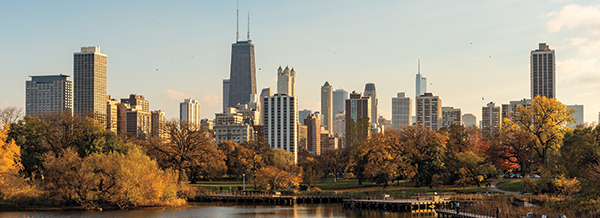
This lens performed commendably at every turn. As seen here, the resolving power is nothing less than impressive. You can crop down to a fraction of the frame and still see considerable detail. View of Chicago skyline from Lincoln Park Zoo. Tech data: ISO 400, f/5.6, 1/1250 second.
Features & Price
Here’s a list of the Canon EF 35mm f/1.4L II USM’s top features, and price:
• Fast f/1.4 maximum aperture
• Several exotic glass elements
• Reduced chromatic aberration
• Coated against flare and ghosting
• Resistant to dust and water
• Fluorine coatings to protect lens elements
• Silent, fast AF
• Full manual focus override during AF
• Locking lens hood
• Fits all Canon DSLRs (35mm converts to a normal lens on APS-C bodies)
• $1,799 street price
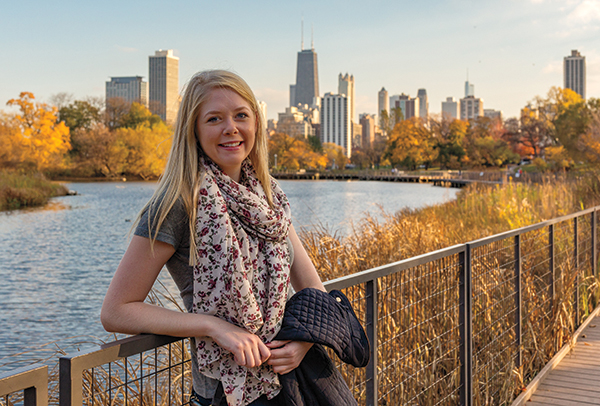
I noticed this beautiful young woman leaning against the fence and explained that I was testing this lens and that I’d like to photograph her for my review. She agreed. The 35mm focal length allowed me to include the surrounding backdrop in a pleasing composition. Tech data: ISO 400, f/5.6, 1/500 second.
Optics & Build
So what is so unique about this lens? This new 35mm offers Canon’s latest proprietary technology: Blue Spectrum Refractive Optics, or BR Optics. That’s a fancy way of saying the lens delivers a cleaner image from the get-go, owing to dramatically reduced chromatic aberration. Chromatic aberration (color fringing) results when different wavelengths of light (colors) fail to focus on a single point.
As Canon explains it: “The molecular design of BR Optics refracts blue light (short wavelength spectrum) to a greater degree than other existing optical technologies including UD (ultra-low dispersion) glass, Super UD glass, and Fluorite, to control color fringing as effectively as possible. When placed between convex and concave lens elements made from conventional optical glass materials, BR Optics help to produce sharp images with outstanding contrast and color fidelity by thoroughly reducing axial chromatic aberration.” What’s more, this lens also incorporates two aspherical elements and one UD glass element to further enhance optical performance.

Even though this silverback gorilla (at the Lincoln Park Zoo) was seated, he was constantly moving head and hands. I carefully focused the lens on his eyes and made this exposure. The lens captured the facial expression and all the revealing detail admirably. To steady the lens I positioned it against the glass (after removing the petal-shaped lens hood to avoid reflections in the shot). Tech data: ISO 1600, f/1.4, 1/40 second.
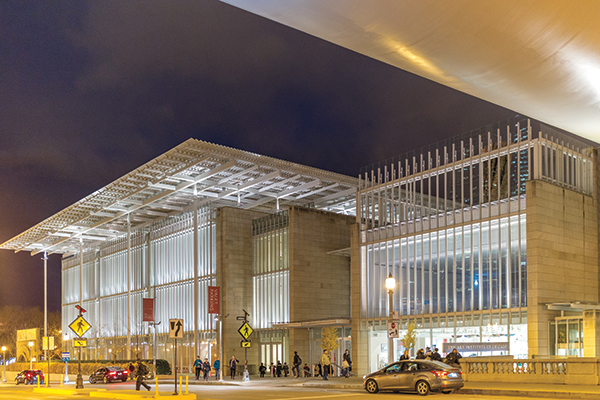
I’d photographed the Art Institute’s Modern Wing with the Canon EF 11-24mm f/4L during the day. Now the challenge was to hold steady and photograph it at night and to see how well this lens would do wide open. No surprise. The lens delivered a beautiful image. Tech data: ISO 1250, f/1.4, 1/40 second.
In The Field
I took the Canon EF 35mm f/1.4L II USM to a variety of locations around Chicago, including one where I wouldn’t normally use a fixed-focal-length lens. For starters, I visited Millennium Park and photographed the various sculptures and surrounding skyline. Next I headed for Lincoln Park Zoo (I was hoping to take advantage of the fast aperture and wasn’t sure what I’d shoot with this lens at the time, but it worked out well). En route to the zoo, I added to a new portfolio I’d been building, one that focused on the interplay of light and shadow. Also on the way there, as well as at the zoo, I photographed a number of people individually and in groups, and that let me fulfill the street candid portion of my shoot list. Finally, I returned to Millennium Park and surroundings late in the day and, lastly, ducked into a hotel for interior shots, with the aim of capturing these architectural elements at maximum aperture (f/1.4) under subdued lighting—to round out that shoot list.
I have to say, the lens did not disappoint during my testing, which was done with a 20-megapixel, full-frame Canon EOS 6D DSLR. During my first few outings, I don’t recall having used manual focus even once, so I made a point of doing so at the end. And then I realized what I was missing by not using it. Manual focus is silky smooth—practically on a par with fixed focals of a bygone era.
I was disappointed that the lens did not feature Canon’s proprietary IS (Image Stabilization). There were times at night when it would have been a welcome addition. I did make use of the lens’s weighty bulk to help stabilize the shots, but can’t say I was happy with the results shot at shutter speeds slower than the optimum (1/focal length). More to the point, shooting hand-held and in aperture priority, I worked best at shutter speeds down to 1/40 second, occasionally managing a steady exposure at 1/30.
I also have to remark on the locking lens hood, which uses a special release—so much easier and more certain than the traditional bayonet design.

I walked into the lobby of Chicago’s magnificent Congress Plaza Hotel with the intent of photographing the interior at f/1.4. The lobby was replete with statues. I chose one against a fairly colorful backdrop free of people. Thankfully there was enough light to avoid excessive ISO settings. Tech data: ISO 800, f/1.4, 1/125 second.
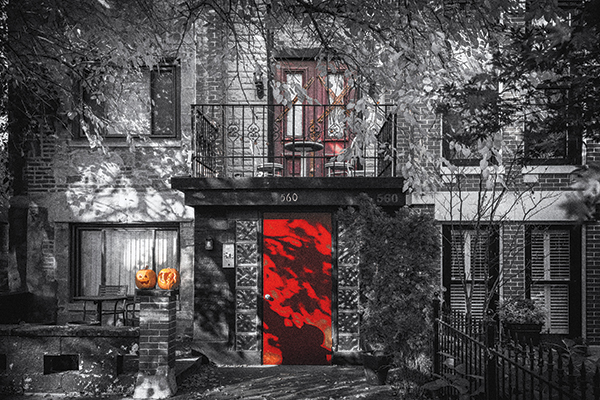
I came upon this location en route to the zoo. I’ve been shooting a series focusing on the interplay of light and shadow and this Halloween scene looked perfect, made all the more gothic by the shadows. I then converted the image to black and white, leaving selected colors in play. Tech data: ISO 100, f/5.6, 1/30 second.
Performance
The new Canon EF 35mm f/1.4L II USM is very well corrected for distortion. Barrel distortion was mildly evident and easily corrected in Lightroom CC. In fact, I found the lens eminently suited to shooting architecture.
I was pleasantly surprised to see that the lens held sharpness across the field wide open. Yes, there was some loss in sharpness at the corners, but it was nearly inconsequential. More to the point, I had no qualms shooting at f/1.4 even when it came to architectural studies. Clearly, stopping down improved results, but only if you’re a stickler for corner-to-corner sharpness. Or to put it another way, this proved to be the perfect lens for low-light studies around town. And it meant I wouldn’t need to resort to exorbitant ISO levels.
Vignetting was another matter. Vignetting was markedly pronounced at f/1.4. By f/2.2 it was largely ameliorated. Fortunately, it was readily dealt with during Raw conversion.
Now to the raison d’être for this high-tech glass: chromatic aberration correction. I’ve seen chromatic aberration (most often in the form of lateral color) rear its ugly head all too often, even in some of the best and newest lenses. So to what extent did the new BR Optics improve the situation? Quite remarkably, I’d say—to the point where I had to really strain to find color fringing. Oh, don’t get me wrong—there is still some lateral color in the image (when viewed at 100 percent), but not enough to initially give the impression of a blurry shot when viewing the uncorrected file. Select “Remove Chromatic Aberration” in Lightroom and you quickly deal with any residual color fringing.

I’d passed this location countless times, always marveling at the almost Escheresque design of these stairs and the enigmatic nature of the scene. The 35mm lens proved a suitable match here, helping me be more decisive with my composition. With a zoom, I would have played around with focal lengths. Tech data: ISO 400, f/1.4, 1/40 second.
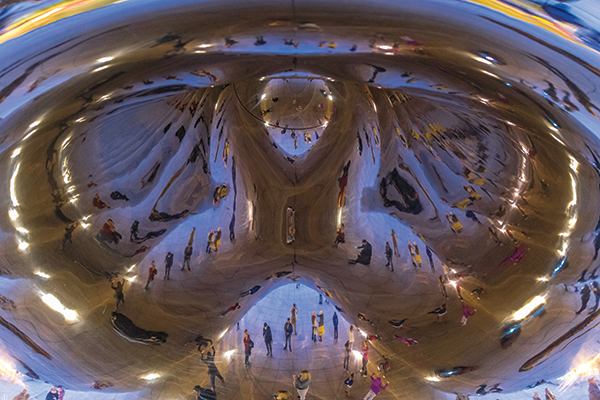
I try to recreate this abstract view of Chicago’s Cloud Gate (“The Bean”) with each wide-angle lens I test. Low-light levels mandated maximum aperture so I wouldn’t have to resort to even higher ISO values. Had this lens been equipped with image stabilization, I would have stopped down and worked with a slower shutter speed to blur movement. Tech data: ISO 6400, f/1.4, 1/40 second.
Conclusion
After my first day of shooting, I knew I wanted this lens, if only I were still a Canon shooter. In fact, I’d recommend it to any photographer looking to replace or upgrade a previous-generation Canon 35mm lens. The fast maximum aperture; the high degree of chromatic aberration correction, sharpness, and overall admirable optical performance; the solid build and great feel in your hands—all this amounts to a lens worthy of any serious photographer’s attention. The only obstacle for some may be the price.
Landscape photographers would do well adding this lens to the Canon EF 11-24mm f/4 they may have purchased recently, especially when it comes to shooting hand-held under subdued lighting. And street shooters and portrait and wedding photographers will find this lens eminently suited to any occasion, especially where the use of flash kills the mood or is otherwise out of the equation. Or use it at maximum aperture for pleasing blurred-out backgrounds. In fact, you can’t go wrong with this lens in any situation where a moderate wide-angle lens is called for. And it’s a welcome change of pace from the ubiquitous zoom we find ourselves using all too often.
(Note: All images were shot hand-held, by available light. Because I could work most proficiently in Lightroom CC, this is where I opted to process my Raw files. All images were processed at the default sharpness setting. Images were not cropped or were cropped minimally, unless otherwise noted.)
- Log in or register to post comments

















































